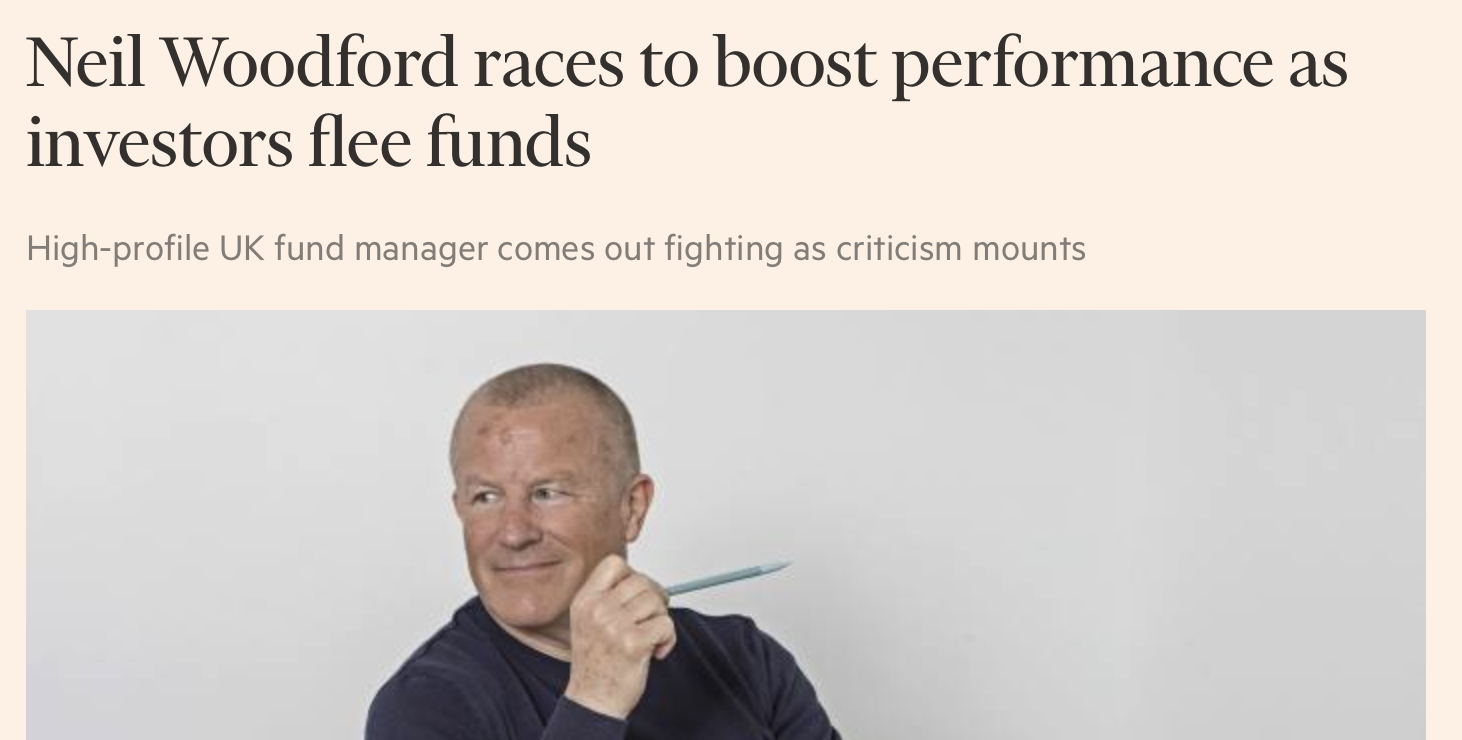
What are we to do about Neil Woodford’s shockingly bad performance? One answer, and possibly the only important one: don’t put yourself in this position again. Opt out of active management altogether and go passive.
Many investment ‘stars’ over the years have disappointed and left their followers with a massive problem: what to do has big consequences yet is really difficult to decide. Collectively it’s also massive because star managers scoop up a lot of private savings before it goes wrong.
It’s not a problem you can avoid by somehow making better selection of either the advisers who are picking managers or of the managers if you are picking them yourself. That’s to draw entirely the wrong conclusion. The insight you need is that the problem of living with your selection is a permanent and unavoidable feature of choosing active managers in preference to investing in low-cost index-tracking funds. So it’s not a problem you need. You choose it or not.
I addressed this in a letter in the FT in August 2016. ‘Investor and agent face not so much a selection problem as a constant reselection problem, as new performance data arrives. An active manager taking large enough bets to beat a benchmark with equivalent risk (so not a closet indexer) will at some point experience poor performance and when it happens yesterday’s star stock picker may be hard to distinguish from a dog. With no help from the data, both investors and agents fall prey to behavioural biases in interpreting what is happening, the handling of which will probably explain outcomes better than the underlying active-management function itself.’
Since I wrote that there has been a growing recognition, not least at the Financial Conduct Authority, that playing the active-management game when the bets off the benchmark are small is self-defeating: the costs of playing are almost certain to exceed even very good payoffs. So stopping doing that yourself, or ditching advisers who you see doing it, has to be sensible. But, unfortunately, playing the game with bets large enough to improve the rationality of the strategy instead exposes you to the star-manager problem that Woodford typifies.
Neil Woodford’s response to investors fleeing his funds in droves is to warn them they may be making a big mistake, because performance may rebound as fast and as much as it collapsed. As long as he keeps taking the same size bets, that may indeed be true. To change that now, he rightly observes speaking to the FT this week, would be a ‘betrayal’. So we think we know something about the bets, which is a help, but we know nothing about the payoffs.
You wouldn’t expect a fund manager in his position to choose to show so little sympathy for his investors’ predicament. In the FT interview Woodford blamed “misinformation” and “lazy commentary” for encouraging “appallingly bad” decisions by investors to dump his funds. “There is a mountain of fake information and fake analysis out in the marketplace which, in the end, does impact investors’ decisions detrimentally. When clients are saying, ‘nah, we want our money back now because we’d much rather be investing in these things that have gone up’, that, for me, is a frustration. I think they’re making a poor investment decision.” He may be right about that too, but it only serves to remind us about those behavioural biases that make it so much harder to decide what to do.
I’ve deliberately framed the decision in this case as a problem described only by the statistics: size of bets, size of possible payoffs, uncertainty about direction of payoffs. I realise that, in this case, there are also some idiosyncratic features of the Woodford strategy that may also shape the actual outcome, such as the effect on the structure of the bets when liquid holdings have to be sold to meet heavy redemptions, leaving higher exposure to riskier, less liquid investments. Maybe in any similar situation there will tend to be some dynamic like this that further complicates the reselection choice. But you don’t even need that extra layer of complexity to draw a simple conclusion: don’t put yourself in this position again.
I’ve also deliberately emphasised the gain in composure that comes with opting out: removing a constant and wearing hassle factor. But of course it also removes a high monetary cost. At the same time as people investing in Woodford Investment Management products are labouring with this reselection choice, they are also possibly seeing for the first time (thanks to the EU’s new comprehensive rules for disclosing a breakdown of all the different costs of investing) that participating in the active management game accounts for about half the all-in costs of the investment-management function, and in many cases even more than half. That’s a subject for another post.